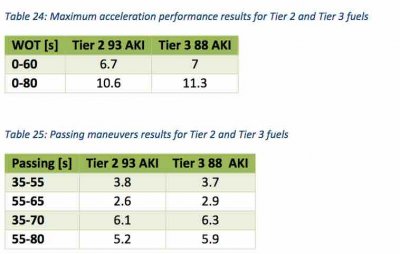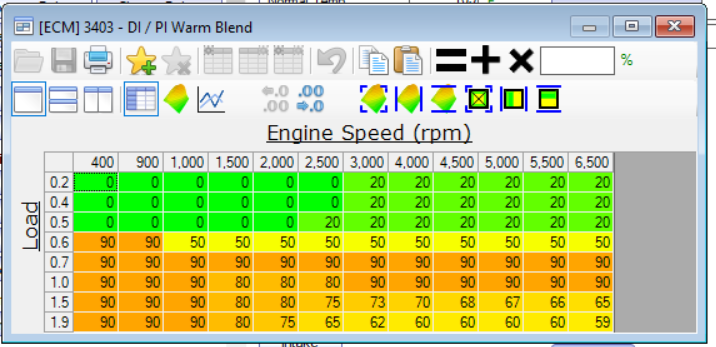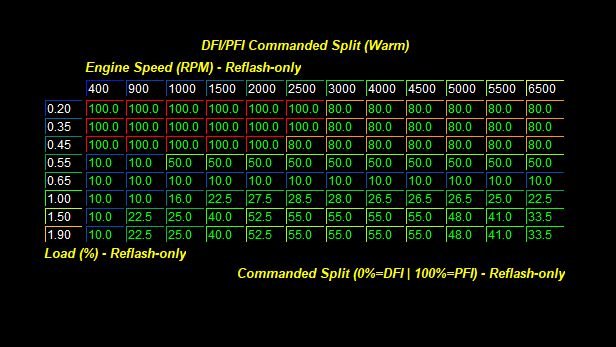Well, I fell down the rabbit hole of the internet yesterday, and from the NHTSA website, ran across this little gem: https://www.nhtsa.gov/sites/nhtsa.dot.gov/files/documents/812520.pdf. "Argonne (National Laboratory) is providing a benchmark report based on chassis dynamometer testing in laboratory conditions for a 2017 Ford F-150EcoBoost. In order to complete this evaluation, the Vehicle System Research Group at Argonne National Laboratory conducted vehicle testing on a chassis dynamometer at its Advanced Powertrain Research Facility (www.anl.gov/d3). The vehicle was extensively instrumented to understand powertrain operation and the impact of specific advanced vehicle technologies on fuel consumption. In addition to this report, the hundreds of available time resolved vehicle signals generated by the testing are provided to Argonne’s vehicle simulation group in order to inform the refinement of Autonomie software and enable validation of the vehicle specific technologies (www.autonomie.net)."
They've been doing this for a number of years, and have tested 150 vehicles over the past 20 years. "A core capability of the APRF staff is the ability to decode the vehicle and powertrain internal communication messages (CAN), which is relevant to this testing. Over the last few years, the APRF staff has developed powerful tools that enable the decoding of both broadcast and diag-\nostic CAN messages."
Lotsa cool graphs, data, and impressions of the function of the EcoBoost V-6. This is a standard F-150, not a Raptor, but I think many of their findings would apply.
Among them:
1. Yes, the engine cuts off fuel flow during higher-speed, closed throttle deceleration. I'd suspected this for a time, as during descents down long hills, mountain passes etc I could see my cylinder head temp (even before the 170 degree tstat install) drop into the 160's. Their summary: "During deceleration the fuel to the engine is cut off while the engine is spun through the transmission and locked torque converter using the kinetic energy of the vehicle. The engine resumes fueling again before the vehicle comes to a full stop."
2. The mix between PFI and DI: The total fuel flow was measured between the low-pressure fuel pump in the tank and the junction that splits the fuel be-tween the DI and PFI systems, using both a positive displacement fuel scale and a Coriolis fuel flow meter. As soon as the accelerator pedal is at 100 percent the intake air boost from the turbocharger starts to build. The fueling system switches from the PFI system to the DI system to quickly settle on 60 percent of the fuel provided by the DI system and 40 percent of the fuel provided by the PFI system.
3. When at speed, going to pass, from 55 mph to 80 mph, the powertrain required about a second after 100 percent application of the accelerator pedal to build up boost and downshift from 10th gear to fourth gear. Similar to the maximum acceleration test, the injection system switches to 90 percent DI initially and settles at 60 percent DI and 40 percent PFI once the intake air pressure is fully built up by the turbocharger.
4. Digging into the above (2 and 3) a bit deeper, they found The PFI system provides the fuel to the engine when the absolute engine load is below 40 percent. The DI system is quickly blended in above 40 percent absolute engine load. Between 60 percent to 140 percent absolute load, 80percent to 70 percent of the fuel is delivered through the DI system. At absolute engine loads above 140 percent the PFI system provides an increase proportion of the fuel up to 40 percent. At the maximum absolute load above 2,000 rpm 60 percent of the fuel is provided by the DI system and 40 percent by the PFI system.
5. interestingly, their graph shows an island of 100 percent DI operation at 575 rpm and 40 percent absolute load that corresponds to the engine starting on the DI system before switching to the PFI system.
I'd be curious as to why this mix of PFI/DI is occurring. Perhaps the physical constraints of the size of the engine prevents using injectors large enough to provide 100% fuel by one system or the other...?? Just a SWAG there for sure. At any rate, it seems that no matter how you're driving, the back sides of the intake valves are being washed by fuel...good to know.
There are graphs on engine spark timing, the fueling map and boost map strategy if you want to see 'em.
Does fuel octane make a difference? Sure does:
The Tier2 certification fuel has an octane rating of 93AKI and the Tier 3 certification fuel has an octane rating of 88 AKI. The Tier2 fuel represents the premium fuel and the Tier3 fuel represents the regular fuel in this investigation. They have tables comparing the energy content, density, etc of the two fuels included. "Tier 2 fuel has a 3.1 percent lower energy content by mass compared to the Tier 3 fuel,which does impact the volumetric fuel economy comparison. At higher absolute engine loads the spark timing for the 93AKI fuel is more advanced enabling the engine to operate closer to the maximum brake torque combustion conditions.For the lower octane fuel the spark ignition timing is retarded at these higher loads to prevent engine knocking from occurring." Their test results from this showed: The fuel economy and powertrain efficiency are slightly higher for the high octane fuel. Passing/acceleration was improved marginally as well:

Well, this is getting pretty long. It's fascinating reading, have a look if you want to kill an hour or two. If you see anything that you think is interesting enough to share with the group feel free to share it as well. And it's publicly available information, I haven't released any corporate secrets here.
They've been doing this for a number of years, and have tested 150 vehicles over the past 20 years. "A core capability of the APRF staff is the ability to decode the vehicle and powertrain internal communication messages (CAN), which is relevant to this testing. Over the last few years, the APRF staff has developed powerful tools that enable the decoding of both broadcast and diag-\nostic CAN messages."
Lotsa cool graphs, data, and impressions of the function of the EcoBoost V-6. This is a standard F-150, not a Raptor, but I think many of their findings would apply.
Among them:
1. Yes, the engine cuts off fuel flow during higher-speed, closed throttle deceleration. I'd suspected this for a time, as during descents down long hills, mountain passes etc I could see my cylinder head temp (even before the 170 degree tstat install) drop into the 160's. Their summary: "During deceleration the fuel to the engine is cut off while the engine is spun through the transmission and locked torque converter using the kinetic energy of the vehicle. The engine resumes fueling again before the vehicle comes to a full stop."
2. The mix between PFI and DI: The total fuel flow was measured between the low-pressure fuel pump in the tank and the junction that splits the fuel be-tween the DI and PFI systems, using both a positive displacement fuel scale and a Coriolis fuel flow meter. As soon as the accelerator pedal is at 100 percent the intake air boost from the turbocharger starts to build. The fueling system switches from the PFI system to the DI system to quickly settle on 60 percent of the fuel provided by the DI system and 40 percent of the fuel provided by the PFI system.
3. When at speed, going to pass, from 55 mph to 80 mph, the powertrain required about a second after 100 percent application of the accelerator pedal to build up boost and downshift from 10th gear to fourth gear. Similar to the maximum acceleration test, the injection system switches to 90 percent DI initially and settles at 60 percent DI and 40 percent PFI once the intake air pressure is fully built up by the turbocharger.
4. Digging into the above (2 and 3) a bit deeper, they found The PFI system provides the fuel to the engine when the absolute engine load is below 40 percent. The DI system is quickly blended in above 40 percent absolute engine load. Between 60 percent to 140 percent absolute load, 80percent to 70 percent of the fuel is delivered through the DI system. At absolute engine loads above 140 percent the PFI system provides an increase proportion of the fuel up to 40 percent. At the maximum absolute load above 2,000 rpm 60 percent of the fuel is provided by the DI system and 40 percent by the PFI system.
5. interestingly, their graph shows an island of 100 percent DI operation at 575 rpm and 40 percent absolute load that corresponds to the engine starting on the DI system before switching to the PFI system.
I'd be curious as to why this mix of PFI/DI is occurring. Perhaps the physical constraints of the size of the engine prevents using injectors large enough to provide 100% fuel by one system or the other...?? Just a SWAG there for sure. At any rate, it seems that no matter how you're driving, the back sides of the intake valves are being washed by fuel...good to know.
There are graphs on engine spark timing, the fueling map and boost map strategy if you want to see 'em.
Does fuel octane make a difference? Sure does:
The Tier2 certification fuel has an octane rating of 93AKI and the Tier 3 certification fuel has an octane rating of 88 AKI. The Tier2 fuel represents the premium fuel and the Tier3 fuel represents the regular fuel in this investigation. They have tables comparing the energy content, density, etc of the two fuels included. "Tier 2 fuel has a 3.1 percent lower energy content by mass compared to the Tier 3 fuel,which does impact the volumetric fuel economy comparison. At higher absolute engine loads the spark timing for the 93AKI fuel is more advanced enabling the engine to operate closer to the maximum brake torque combustion conditions.For the lower octane fuel the spark ignition timing is retarded at these higher loads to prevent engine knocking from occurring." Their test results from this showed: The fuel economy and powertrain efficiency are slightly higher for the high octane fuel. Passing/acceleration was improved marginally as well:

Well, this is getting pretty long. It's fascinating reading, have a look if you want to kill an hour or two. If you see anything that you think is interesting enough to share with the group feel free to share it as well. And it's publicly available information, I haven't released any corporate secrets here.



